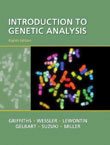For nearly three decades, from edition to edition, An
Introduction to Genetic Analysis (IGA) has evolved side by side
with genetic research, providing an experiment-based
introduction to fundamental concepts that reflects every major
laboratory and conceptual breakthrough. With authors who are
leading researchers, innovative educators, and acclaimed
writers, the book has kept pace with the dramatic expansion of
the field while finding better ways to help students learn how
to put genetics concepts to work.
Now the text that has been used by over three-quarters of a
million students returns in the most extensively revised new
edition in the book's history, once again shaping its coverage
to match current research and thinking in genetics while
providing stronger pedagogical support. The edition features a
new coauthor Susan R. Wessler (a member of the National Academy
of Sciences), dramatic new content and art, reorganized
structure, new learning tools, and state-of-the-art media and
supplements, making it the ideal text for preparing today's
students for tomorrow's genetics.
An Introduction to Genetic Analysis
Eighth Edition
Anthony J.F. Griffiths (U. of British Columbia)
Susan R. Wessler (U. of Georgia)
Richard C. Lewontin (Harvard U.)
William M. Gelbart (Harvard U.)
David T. Suzuki (U. of British Columbia)
Jeffrey H. Miller (U. of California, Los Angeles)
1. Genetics and the Organism
Contains a new section introducing model organisms
1.1 Genes as determinants of the inherent properties of
species
1.2 Genetic variation
1.3 Methodologies used in genetics
1.4 Genes, the environment, and the organism
PART I: TRANSMISSION GENETIC ANALYSIS
2. Patterns of Inheritance
All patterns of inheritance are now in one chapterincluding
extranuclear inheritance
2.1 Autosomal inheritance
2.2 Sex chromosomes and sex-linked inheritance
2.3 Cytoplasmic Inheritance
3. The Chromosomal Basis of Inheritance
A new chapter organization builds concepts logically and
clearly.
For pedagogical unity, the material on chromosome
segregation in tetrad analysis of haploids has been relocated to
this chapter.
Description of all chromosome types, including organelle
chromosomes, is now in one chapter.
3.1 Historical development of the chromosome theory
3.2 The nature of chromosomes
3.3 Mitosis and meiosis
3.4 Chromosome behavior and inheritance patterns in
eukaryotes
3.5 Organelle chromosomes
4. Eukaryote Chromosome Mapping by Recombination
All mapping is now under one roof with the inclusion of
mapping by tetrad analysis and mapping functions in this
chapter. The former special eukaryotic mapping chapter is
eliminated.
4.1 The discovery of the inheritance patterns of linked genes
4.2 Recombination
4.3 Linkage maps
4.4 Using the chi-square test in linkage analysis
4.5 Using Lod scores to assess linkage in human pedigrees
4.6 Accounting for unseen multiple crossovers
5. The Genetics of Bacteria and Their Viruses
Minor streamlining and reorganization to improve
accessibility.
5.1 Working with microorganisms
5.2 Bacterial conjugation
5.3 Bacterial transformation
5.4 Bacteriophage genetics
5.5 Transduction
5.6 Physical maps versus linkage maps
PART II: THE RELATIONSHIP OF DNA AND PHENOTYPE
6. From Gene to Phenotype.
A new slant focuses this chapter (formerly called Gene
Interaction) on the molecular steps between genes and the
phenotype.
The work of Beadle and Tatum is relocated to this chapter
to make a transition from the transmission genetics of chapters
2, 3 and 4 into molecular genetics from here on.
To make this change of gear work, the chapter has been
moved so that it is now Chapter 6 instead of Chapter 4.
6.1 Genes and gen


